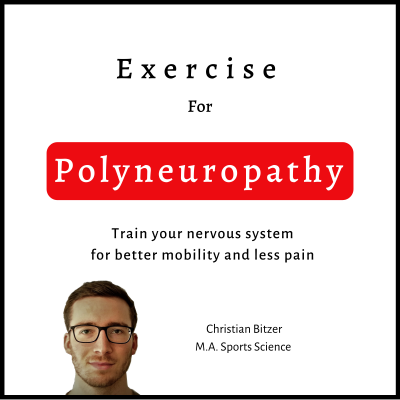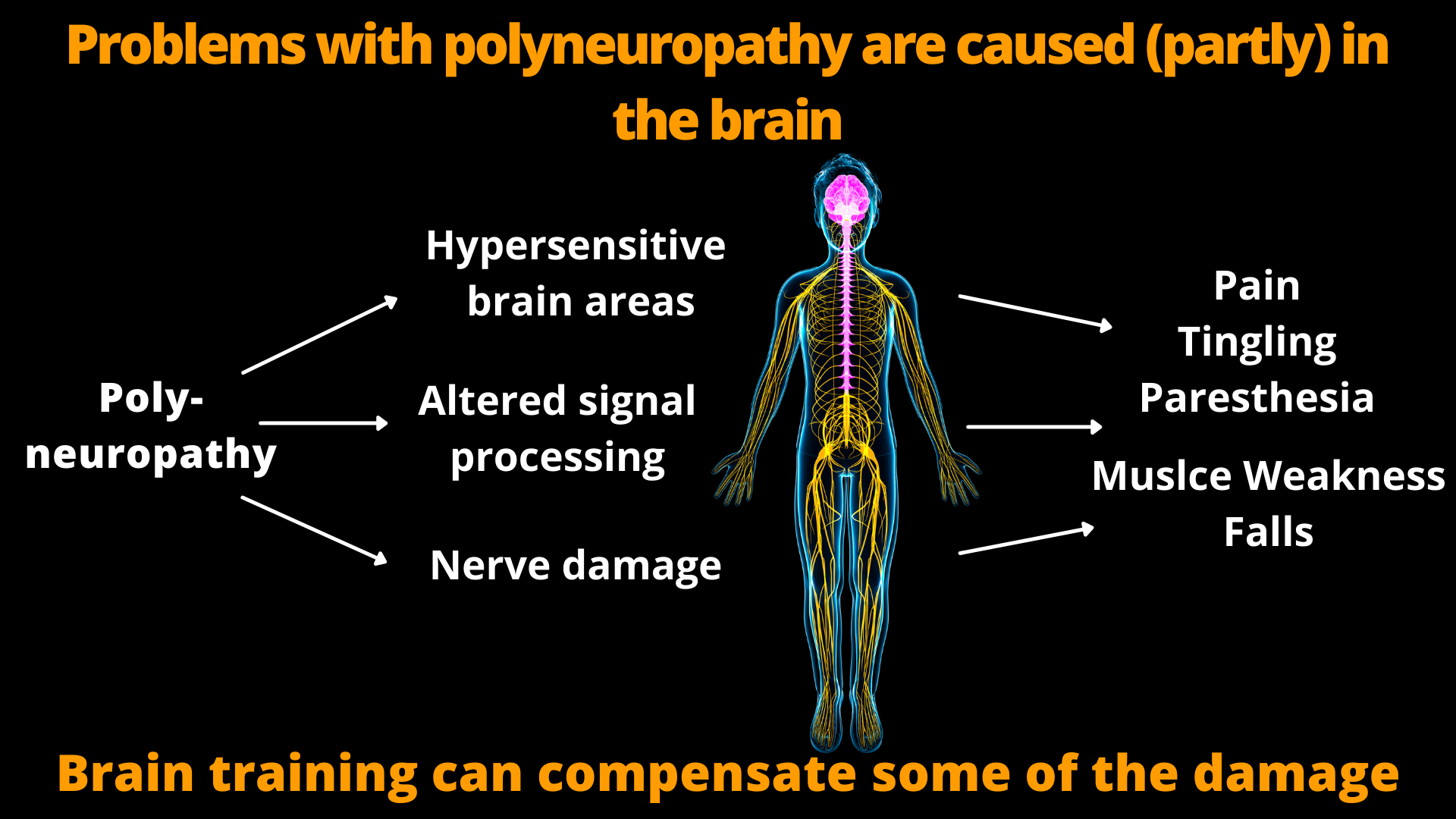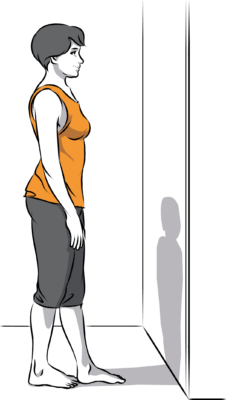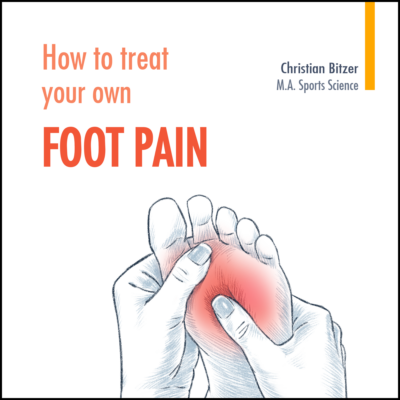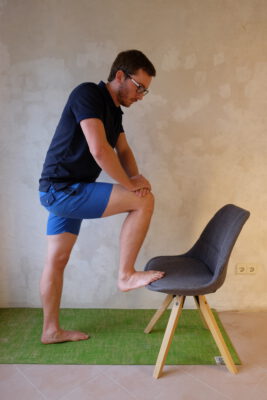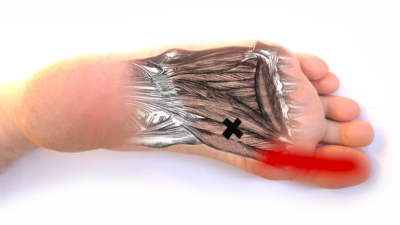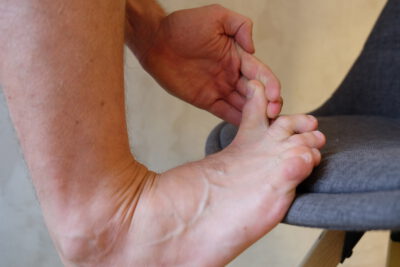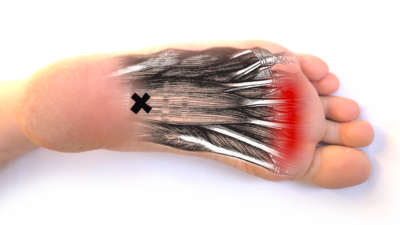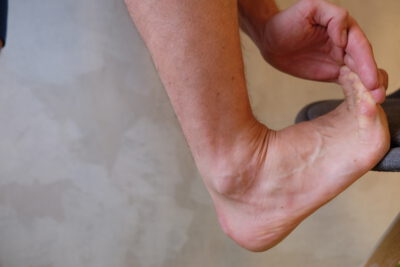Walk better and more safley again with simple exercises
That's what every polyneuropathy patient wants: to walk well and without fear. The right exercises for polyneuropathy to walk and stand safely again can be found on this page. Do you want to improve your own quality of life, reduce symptoms, improve your sense of balance and performance in everyday life - and all this should be possible without pills and medication with a few simple exercises? Even at home? You can. With balance training - as you'll see in a moment, and you can immediately follow along at home, in the office, anywhere.
Why these exercises help with polyneuropathy
To achieve real success you need to understand why this training works. Watch this video to learn all about how Balance Training can help you. After watching this video you will better understand how the exercises from the other videos work.
Why you need to practice by yourself
We all initially think that with something as complicated as polyneuropathy, you should get help from healthcare professionals instead of taking care of it yourself. But the problem with polyneuropathy is that there are hardly any medications that help. Also, while physical therapy is important and helpful for polyneuropathy, there is simply not enough time to accomplish much.
Because even if physiotherapists try very hard, a few appointments will hardly leave enough time to change much. (I speak from my own experience as a therapist here).
Therefore, any serious therapist will confirm that you need to practice by yourself in order to achieve anything. Because the exercises should trigger a training effect. However, this can only develop if you train often enough. It doesn't have to be long or physically demanding. The most important thing is to train the nervous system often enough! And that is only possible if you do it yourself.
Beyond the exercises I present here, physical therapy can help you with vibration training, electrotherapy and massage. These three physical therapy methods can help with polyneuropathy pain in very different ways. Balance training, however, is what you can most easily do yourself at home.
Always stay safe
Before you get started with the exercise for polyneuropathy: Make sure you can not fall while exercising.
Ideally, you should stand between a table and an armchair. If you then lose your balance you can hold on to the table or if you fall backwards, you will simply sit down on the chair. Thus, you minimize the risk of falling. Alternatively, you can stand in a door frame and keep your hands close to the frame at all times so that you can hold on to it immediately.
The last thing we want to happen is for you to fall and injure yourself while doing these exercises!
Do you have any questions?
Anyone who is serious about improving his or her balance will sooner or later have questions ranging from "Am I doing this right?" to "How often can or should I even practice in my condition?" to "What else can I do for myself beyond this?" I regularly answer these questions individually and personally - so that my tips and training programs really fit you personally. Customized individually. I accompany many patients in this individualized way. You too are welcome.
Get your individual consultation! Call me (+49176 66 86 91 51) or Email me!
Example exercises for safe standing despite polyneuropathy
To practice standing safely you can start very simply:
For example, hold onto a table and place your feet right next to each other so that they touch. When you are standing safely let go of the table.
Should you be able to stand like this without wobbling, simply place one foot slightly forward so that the toe and heel are touching. This makes the exercise much more difficult and your nervous system has a harder job to do.
If this is also easy for you, you can next try standing on one leg. You can make all of these exercises more difficult by closing your eyes. This eliminates the information your eyes provide to help keep your balance and your nervous system will rely on self-awareness in order to control your movements. So the signals that the nerves send from your body, for example from your feet, have to be processed in order to maintain balance. This forces the brain to learn to notice exactly what is happening in your legs despite the limitations caused by polyneuropathy. Therefore, exercises with your eyes closed significantly increase the training effect.
However, when exercising with your eyes closed, take special care to not running a risk of falling!
Exercises for safe walking despite polyneuropathy
In order to move independently - whether at home from one room to another or outside walking, in the street or crossing the hallway at work - safe walking is crucial. This video will give you exercises to regain your ability to walk safely.
Again, start with the easiest variation and then work your way up to the more difficult exercises.
Start by simply walking in slow motion. The slower you walk, the longer you have to stand on one leg while the other leg is moving forward. This will train your balance and improve your security while walking.
If this works well for you move on to the next level of difficulty: lift the knee with each step. This makes it a little harder to keep your balance and your nerves have to work even harder.
To a further increase difficulty, you can try doing the same exercise with your eyes closed, or walking on your tippy toes. However, always make sure not to take any risk of falling!
Another good exercise for walking with polyneuropathy is to take really long steps. Many patients tend to take very short tripping steps. However, this is a very unstable way of walking and is also more strenuous and slower than normal walking. So it is a good idea to train your stride length. Find a route in your home that you need to travel frequently, such as the hallway. Now count how many steps you need to do this. In the future, try to take really big steps and make the distance with fewer steps. By the way, you can do this exercise without any problems even if you can only walk on a walker due to polyneuropathy.
Get you exercise guide
If you are looking for more exercises, with more detailed explainations including many inllsutration, you can order your guide "Exercise for Polyneuropathy".
Stand safely while distracted
To be well protected from falls in everyday life, you must be able to keep your balance even under distraction. Because you don't fall in real life as long as you focus on keeping your balance. You fall when you are distracted and your attention is caught by something else.
For everyday safety, the balance must therefore be maintained quasi-automatically. And you can do that by practicing under distraction. The best way to do this is to throw a ball while doing balance exercises.
Here too, of course, it is important to choose the right level of difficulty. You can start by standing with your legs closed and placing a ball from one hand to the other. If that's too easy, you can juggle the ball or throw it against the wall and catch it again, for example.
Practicing with a good mood works better
By the way, all exercises work better when they are more fun. Therefore, it is very useful to practice together with a training partner. In fact, training is nothing more than a learning process on a neurological level. And as always with learning, it works better when you're in a good mood. Good mood improves memory and learning.
Therefore, if you particularly enjoy certain movements, it makes sense to do them more often. Therefore, if your fitness level allows it, it is also useful to incorporate movements into your polyneuropathy training that you are familiar with from other sports. Also practicing with children or good friends is also better than practicing alone.
Exercises for the hands with polyneuropathy
In order to reach the hands more specifically, further coordination exercises are useful. Here, as in all previous exercises, it is important to train the body awareness, this time specifically in the hands. As with the exercises shown so far, the important thing is not to make a great effort, but to perform the movements as safely and well controlled as possible in order to stimulate the nervous system.
- Balance a bottle or a stick
Something similat to balance training can also be done with your hands, which also improves movement control and body awareness despite the polyneuropathy. To do this, take an empty plastic bottle, ideally 1.5 l (~ 60 ounces) or a stick of about 50 cm (~1,5 feet). Place it on the palm of your hand and balance it there without holding on to it with your fingers. If this is too easy for you, place the bottle on the lid.
If you can do this easily, you can combine the exercise with one of the exercises for standing safely (see above). - Bend or stretch fingers individually
Try alternately flexing or extending your fingers one at a time. For example, bending or stretching only the index finger or only the ring finger. As an enhancement you can try to move two fingers at the same time, for example only the index finger and the ring finger or only the middle finger and the little finger, while not moving the other fingers. - Open and close buttons
Very many people with polyneuropathy report that they have problems with opening and closing buttons. That's why it makes sense to practice doing just that. To do this, take a shirt or blouse on which you can still open and close the buttons relatively easily. Open and close the buttons over and over again. The best way to do this is to stand in a position where you can also train your balance, e.g. stand with your feet touching each other or, if you still have good balance, stand on one leg and then start opening and closing the buttons. The more often you practice this, the longer you will still be able to open and close the buttons, even if the polyneuropathy gets worse. - Writing nicely. This is an exercise that is especially useful if you have polyneuropathy but do not yet have problems with writing. Try to write especially nice and precisely. At first glance, this seems like a regular thing to do and is certainly not a spectacular exercise. However, the better you can control the pen, the better the signal processing in your brain, which can help with the symptoms of polyneuropathy (see below). Moreover, if the polyneuropathy worsens, you will not have problems with writing as early if you practice this early on.
In addition, all activities in which you train fine motor skills are useful. For example, drawing, knitting or even building car models. Just pick one activity you like. This improves the body awareness and the movement control of your hands, so that you can at least partially compensate for the deterioration due to the polyneuropathy. Of course, such things are more difficult and perhaps less fun when you are limited in the fine motor skills of your hands due to polyneuropathy. Nevertheless, it is very important to practice them anyway. This not only leads to continuing to be better at these things. It is also very likely that such training will also help against pain and numbness of the hands by improving signal processing in the brain, as you will see in the next paragraph.
How this training helps against polyneuropathy
To improve polyneuropathy, you have to make the nervous system function better. In order to achieve this, the nervous system must be given tasks that are not easy to do. The nervous system then responds with a learning process. In particular, it learns to process stimuli from the body better and also to react to them better.
When you train your balance, your nervous system must constantly sense how your body is moving. It also has to keep reacting and making minute changes in the tension of the individual muscles in your body. It is therefore necessary to feel and control the body very precisely in order to be able to maintain balance.
So when you train balance, your nervous system has to do an impressive job. And even more so if you suffer from polyneuropathy. Because then, of course, the nerve damage makes this task more difficult to do. However, you will benefit even more if you practice anyway. Because an improvement in balance also brings an improvement in the symptoms of polyneuropathy! (You can read a study on the topic here: Kleckner 2018).

Polyneuropathy interferes with the central nervous system!
Polyneuropathy disturbs the perception of your body, as everyone who suffers from it knows from their own experience.
But this does not only come from having damage in your feet or finger tips. Polyneuropathy also affects the central nervous system in particular.
The nerve damage in the periphery of the body make it impossible for the brain to interpret the signals coming from the body correctly. This often leads to numbness or loss of perception. For example, one patient told me she had stepped in a nail and only realized she had hurt herself when she saw blood on the floor. So her nervous system was no longer able to send a pain signal to the brain.
Pain in polyneuropathy originates in the brain!
Very often, however, the nervous system reacts through hypersensitivity. You might say it tries to "listen more closely". It therefore amplifies the signals that arrive in the brain. As a result, things that are actually normal are then perceived as unpleasant or painful. For example, another patient told me that wearing normal socks already causes her pain and she can only wear extremely soft socks. So her nervous system reacts far too strongly to everyday stimuli.
Many patients know such problems from their own life and often have tremendous problems because of it.
It is important to understand where these problems arise in order to make an effort to improvement. So to do something about the problems you first need to know:
The symptoms of polyneuropathy arise not only in the hands and feet, but also in the brain!
And that's great news because the brain is the most adaptable organ we have. So it can be trained better than any other organ.
You can find a detailed article on this here: Why does polyneuropathy hurt?
The nervous system is our most adaptable organ!
If you train balance, this mainly causes an adaptation in the brain. To keep your balance, your brain must perceive, interpret and respond to signals from the entire body all the time. The better this process works, the better you can maintain balance.
If you do the exercises for polyneuropathy presented here, you will improve this process. As a result, your nervous system learns to process and respond better to stimuli.
This improves both your perception and control of your body. This means that you will feel less discomfort and be able to control your movements better.
Therefore, if you manage to stand safely on one leg despite having polyneuropathy, this will also improve the symptoms of polyneuropathy. Fine motor skills improve, you can walk more confidently and many patients report reduced pain and discomfort.
You read find more about self-help for pain in polyneuropathy here: Pain in polyneuropathy and what you can do about it.
Training for polyneuropathy does not have to be strenuous!
So, the exercises in polyneuropathy trigger an adaptation of the nervous system. This means that a learning process is taking place. This is because an adaptation of the nervous system is nothing other than learning. Therefore, you do not have to exert yourself during the exercises. This is not to build muscle or train endurance. It's all about nerves.
In fact, it's better not to exert yourself physically and instead take regular breaks. This is because the nervous system is best able to learn in a fresh, fatigue-free state. It is similar to any other learning process. Just like learning how to calculate or vocabulary in a new language: in the long run, it's more beneficial to practice regularly for a few minutes than to spend hours cramming until your head starts spinning right before a class test.
That's why I recommend the Balance Set for Polyneuropathy, with which you can practice at home at your own pace and with the level of difficulty that suits you.
You can train with it at home, without overstraining and at any time.
Scientific evidence for effects of exercises in polyneuropathy
By the way, the effects I describe here have been observed in scientific studies. I myself had the opportunity to do research on the subject in the sports oncology department of the University Clinic in Freiburg, Germany. There, even the sports scientists who conducted the studies were surprised by the effects of balance training on polyneuropathy.
At that time, balance training for polyneuropathy was still something more or less exotic. In the meantime, however, the positive effects have been shown in numerous studies. Balance training was accordingly also included as a therapeutic measure in the treatment guidelines for polyneuropathy after chemotherapy and due to diabetes.(German National Health Care Guideline for Neuropathy in Diabetes, S3 Guideline for Oncological Therapy).
If you are interested in scientific studies on exercise in polyneuropathy, here are some selected papers:
Kneis et al. (2014)
Streckmann et al. (2018)
Vollmers et a. (2018)
Streckmann et al. (2014)
Tofthagen et al. (2014)
Kleckner et al. (2017)
Akbari et al. (2012)
Duregon et al. (2018)
Vollmers et al. (2018)
Additional strength and endurance training is useful in polyneuropathy!
In addition to the exercises shown here, it is very useful to do strength and endurance training.
In some studies, it has been shown that the effect of balance exercises is enhanced when strength and endurance are also trained.
This means that if you do classic fitness training and also train the nervous system through balance exercises, you achieve a combined effect that is particularly strong.
However, strength and endurance training alone, i.e., without balance exercises, has been shown to have very little effect on polyneuropathy. After all, it is not the nervous system that is specifically trained, but rather the muscles and the cardiovascular system. So it's best to do both: Balance training and additional strength and endurance training.
Prevent injuries and falling!
The most important thing when playing sports with polyneuropathy is to make sure you don't hurt yourself. People who suffer from polyneuropathy have poorer movement control and therefore a greater risk of falling or tripping and injuring themselves.
So you should be a little more careful when playing sports. However, sport is always associated with a certain risk and with exaggerated caution, exercise is no fun, because after all, you do not want to constantly think about the risk of injury. Therefore, you should pay special attention to balance training, because it protects from falls.
It's pretty obvious: if you lose your balance faster, you'll fall faster. Those with well-trained balance are less likely to fall.
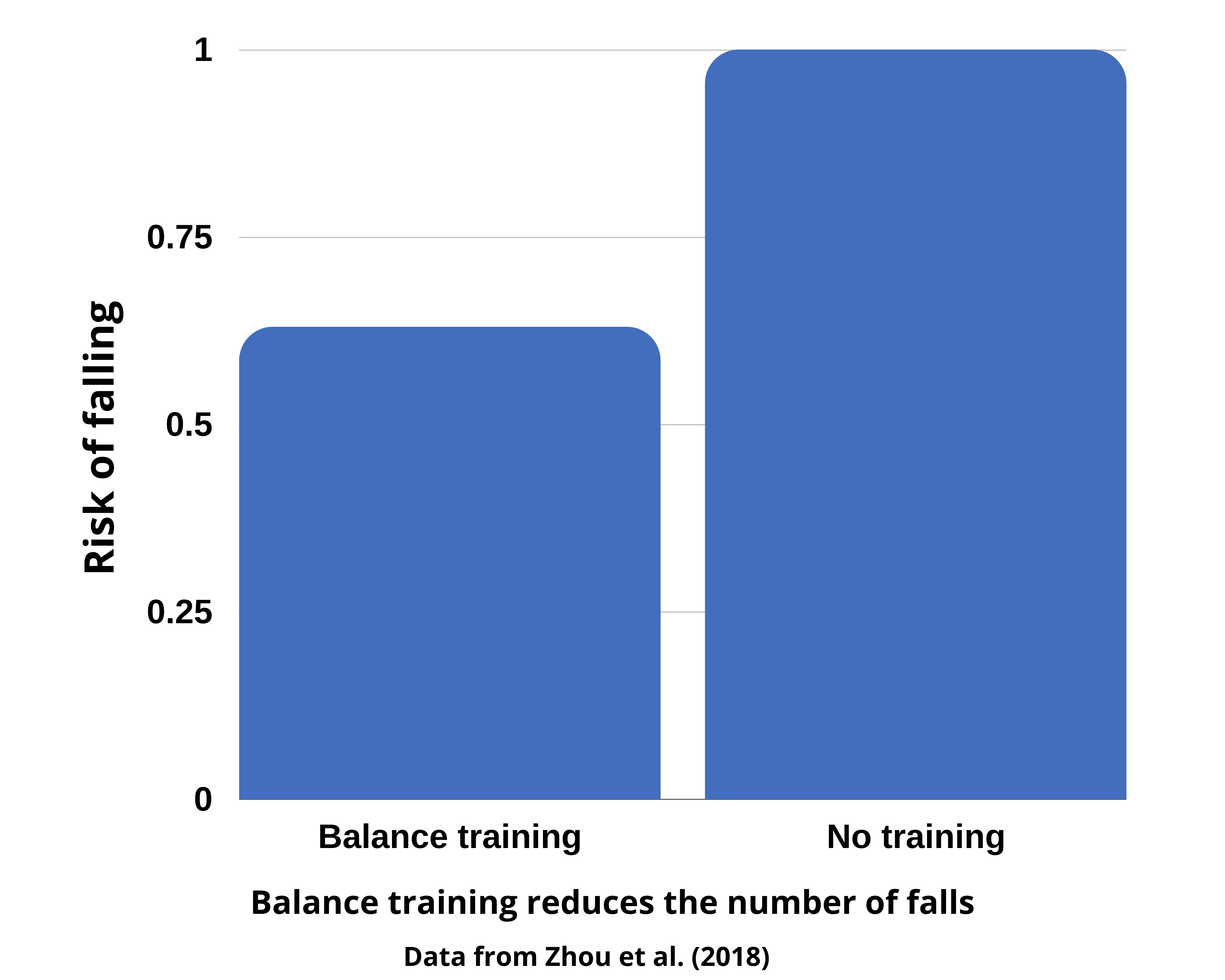
Sports injuries become less frequent with balance training
By the way, this does not only apply to falls; sports injuries are also less frequent in people with well-trained balance.
This is because the improved perception and better movement control prevent you from getting your joints into dangerous positions. This means that people with a well-trained balance can feel more precisely in which position their joints are. So if they sense a joint moving into a dangerous position, they react earlier. This prevents joints from being twisted or torn.
So when athletes train balance in addition to normal training, they protect themselves from injuries, especially to the ankle and knee.
This happens automatically and of course without thinking about it if you are well trained. So a well trained nervous system protects you without the need for extra effort.
If you want to do sports despite polyneuropathy, it is therefore extra important to train your balance!
You can find a detailed article on injury prevention here: Never twist your ankle again

Fitness can be increased despite polyneuropathy - even in old age
By the way, training is also possible for people who suffer from severe polyneuropathy and are very old. The body then even benefits particularly from the training.
Of course, with age and polyneuropathy, you become physically weaker. However, if you don't exercise, the negative effect of inactivity adds to the effects of polyneuropathy. When muscles are not used, they shrink and get weaker. This is true at any age and even in healthy individuals. Because organs that the body does not use are reduced in order to save energy.
On the other hand, when sick and elderly people exercise anyway, great positive effects often occur.
It is important to increase your training load or difficulty slowly. For example, if you can do 10 squats today, try to do 11 or 12 by next week. Such a small increase is usually possible and seems quite unspectacular at first. However, these small improvements make a huge difference over time!
In the graph to the right, you can see the evolution of the squat performance of one of my patients who consistently trained according to this system. He was still able to substantially increase his performance at the age of 91. And he is no exception. I very often see patients who can improve their strength this way.
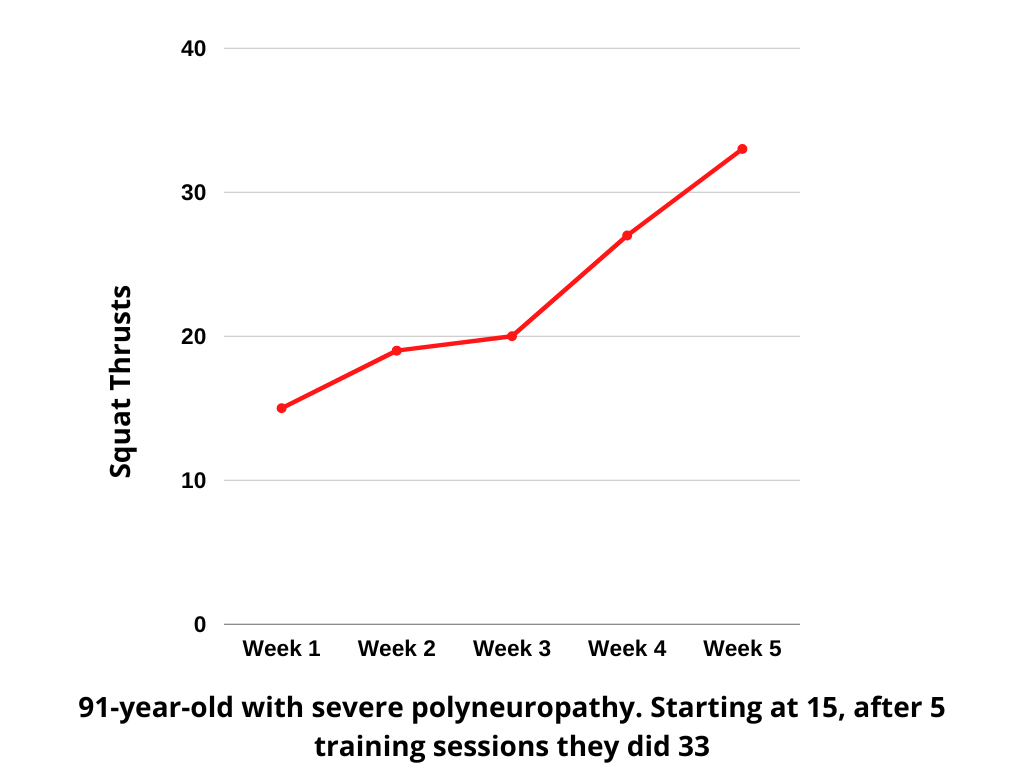
How to activate more muscle fibres despite polyneuropathy
The nervous system plays a crucial role in muscle strength. Each muscle fiber must be activated by a nerve ending, otherwise it cannot develop any force.
In polyneuropathy, nerve endings are often missing or signals are not transmitted as well. Therefore, people who suffer from polyneuropathy often have less strength.
However, this can also be trained. This is because anyone who starts strength training also triggers a training effect in the nervous system. Here it does not matter whether one suffers from polyneuropathy or is completely healthy. First, the body learns to activate more muscle fibers at the right time; only once this process is done, the muscles begin to grow in size. Therefore, it is possible to increase strength without getting thicker muscles.
If people you start strength training, this happens all the time. Because before the body grows bigger muscles, it first begins to better use the muscles that are already there. This means that if you start lifting weights, new nerve endings grow into the muscles. After some time, however, this process comes to a limit and the body instead allows the muscles to grow larger. However, targeted training methods can still achieve a training effect on the nerve endings.
This has long been used by athletes who need great strength, but not thick and heavy muscles. Climbers or athletes in sports with weight classes, for example. They must be light, but still very strong.
However, if you are just starting out, you don't need to worry about such special training methods yet. Even normal strength exercises are then sufficient to stimulate the nervous system.
The most effective strength exercise for you feet and calf in polyneuropathy
The most noticeable loss of strength for most polyneuropathy patients occurs in the feet and calves. The best exercise to maintain muscle strength in this area is the so-called calf raise.
To do this, simply get up on your tippy toes and then lower your heels again. During thin movement, the heels should be lifted up as far as possible. It is important to keep the knees extended the whole time and not to sway back and forth with the whole body, but to lift the body only with the strength of the calves.
If you have problems keeping your balance, you can hold on to a table or the back of a chair during the exercise. If you cannot manage to lift your body with the strength of your calves because your muscles are already weakened due to polyneuropathy, you can also try to support part of your body weight on the table with your arms. This allows you to train your calves even if they are very weak.
On the other hand, if the exercise is very easy for you, you can do it standing on one leg.
In contrast to the balance exercises, however, you should make an intense effort with the strength exercises if you want to achieve a training effect - i.e. more strength.
The most effective strength exercise for your hands
To maintain the strength of the hands despite polyneuropathy there is a very simple exercise:
Take an elastic ball into your hand. If you are quite strong take a tennis ball, if you have less strength take a similar sized softer foam ball. Simply squeeze the ball with your hand and release your grip again. Take two seconds each for squeezing and two seconds each for relaxing. Repeat this movement until you feel a clear sensation of exertion in your hand and forearm. However, do not do this exercise too often. Once you have done this exercise very intensely, give your hands a rest for 48 hours and do this strength exercise again only after this recovery period.
This exercise will help you, despite polyneuropathy, for example, to open water bottles or jars and to do all the everyday things for which you need muscle strength of the hands.
Balance training also increases strength
By the way, at least to some extent, you will also achieve an improvement in muscle strength through balance exercises. Those who train their balance with the exercises for polyneuropathy from my bookare also able to better activate their muscle fibers. People who train balance are therefore better able to activate their strength quickly and purposefully.
That's why ski jumpers, for example, do a lot of balance training. Because these exercises put them in a position where they can apply their strength very quickly and thus jump a little further. So the training principle that is used is exactly the same as in the exercises for polyneuropathy.
Of course, as a polyneuropathy patient, you should not do the same exact exercises as ski jumpers. But the training principle is the same: You train the nervous system, not the muscles!
Physical fitness offsets limitations due to polyneuropathy
However, the goal of strength training for polyneuropathy is of course not just to get stronger. After all, polyneuropathy patients are not competitive athletes.
The goal of strength exercises and balance exercises for polyneuropathy, is to compensate for weaknesses in one part of your body with the strength of another part.
For example, if you have weak calf muscles, your thighs will have to do more work. Strong arms can also help you in everyday life when your legs don't cooperate as well. That is why it is very important to train the whole body, rather than just individual parts.
Do stretching exercises help with polyneuropathy?
When you think of exercises for health, the first thing that comes to mind for many people is stretching. And this is also the case with polyneuropathy. Therefore, if you search the Internet for exercises against polyneuropathy, you will find stretching exercises very quickly.
Can stretching help the nerves in polyneuropathy?
Of course, the question is whether stretching exercises can help with nerve damage. After all, stretching really just means to pull on a structure. With classic stretching exercises, as known from sports, muscles and tendons are stretched. But there are also special stretching exercises for the nerves. This happens especially when during a classical stretch, e.g. of the calf, the head is additionally moved. This is because, as the nerves form a continuous cord from the ends of the limbs to the brain. So if you do a regular stretch and then also move the head, you can stretch the nerves.
So it is quite possible to specifically stretch the nerves. However, it is not known whether a healing process can be triggered by pure stretching. Unfortunately, so far it seems that stretching the nerve itself does not do a lot.
Effectiveness of stretching exercises on the nerves is not scientifically proven
There is no evidence from the scientific side that stretching specifically for the nerves could help anything in polyneuropathy. It is true that there are animal experiments in which the poor test animals were administered poisons that damaged the nerves, causing polyneuropathy. When the nerves were stretched during this procedure, there was actually less severe polyneuropathy (Zhu et al. 2018). However, whether this also works in humans among which the polyneuropathy has completely different causes has not yet been shwon.
In my experience there is little effect on the nerves - but a big one on the muscles
I have tried such special nerve stretches with some patients in my own practice. Unfortunately, I did not notice any improvement in nerve function. Of course, this is not reliable scientific proof, however, as already mentioned, there is no evidence from other sources for an improvement of polyneuropathy by stretching.
However, there is still a positive effect from stretching exercises in polyneuropathy:
Stretching exercises can prevent and alleviate muscle hardening. Because they reduce the tension in the muscles.
Stiff and hardened muscles are very common in polyneuropathy
Excessive muscle stiffness, especially of the calf muscles, is a very common problem that I see almost without exception in patients with polyneuropathy. This is because the movements no longer function as they do in a healthy person due to the nerve damage, and this very very often leads to the muscles hardening.
And these hard muscles can cause problems - in addition to polyneuropathy - in many different ways:
1. hardened muscles are weaker than relaxed muscles
A hardened, cramped muscle naturally cannot work as well as a muscle in a normal state. So if you already have weakened muscles due to polyneuropathy, then hardening of the muscles further exacerbates this issue.
2. hardened muscles can cause tremendous pain.
The most common cause of pain in the musculoskeletal system are hardened muscles, the so-called myofascial pain syndrome. This is the reason why, for example, massages can help with pain, because they loosen the hardened muscles, which reduces pain.
If you have pain due to polyneuropathy and hardened muscles are added to this problem, this will also worsen the pain. If the hardened muscles are then released, the pain also improves. I have even had patients with polyneuropathy whose pain completely disappeared due to the treatment of the musculature.
However, each hardened muscle causes pain in different places. These are felt by most people in the same (or at least similar) places. Therefore, it is possible to predict where pain will be felt according to which muscle is tight. This is often a completely different spot than where the muscle is hardened. In the images below you can see in red where the pain is felt, the place where the crosses are marked where the muscle hardening is. Extensive stretching can reduce and prevent such hardening.
Therefore, if you suffer from chronic pain of the feet, it is always worthwhile to stretch the muscles and loosen hardenings. This is because it is practically impossible to distinguish whether the pain is caused by nerve damage and polyneuropathy or by cramped muscles. In very many cases, both causes of pain combine. So you don't know if treating the muscles can reduce pain until you have tryed it. My recommendation for people with polyneuropathy is to basically stretch the muscles extensively. Negative side effects are unlikely, but pain can often be reduced or at least prevented from worsening.
3. hardened muscles can compress nerves
There are some narrow places where muscles and nerves share relatively narrow space. When the muscle hardens, it changes its shape due to the fact that it is permanently shortened. That is, it becomes thicker in certain places.
This can cause the muscle to press on the nerve at the narrow spots, further impairing the function of the nerve, which is already damaged by the polyneuropathy.
Examples for this are at the cervical spine and the lower legs. The musculi scaleni, and the nerves that supply the fingers, run parallel along the cervical spine. If the muscles harden, this can cause problems throughout the arm, all the way down to the fingertips. The same is true in the lower leg, where the fibularis longus muscle can compress the nerves that supply the toes.
If such nerve compression is present, treatment of the muscles can produce impressive improvements. This possibility is often overlooked in people with polyneuropathy, as all complaints are blamed on the polyneuropathy and no additional causes are considered.
Therefore, in the following paragraphs I will show you exercises to stretch the muscles of the feet and the muscles of the hands to keep normal muscle tension despite polyneuropathy. Stretching exercises of the hands and feet can help relax muscles, relieving the pain and discomfort of polyneuropathy.
Stretching exercises help can with polyneuropathy - by helping the muscles
All these problems can be prevented by regular stretching exercises. So we can say that stretching exercises in polyneuropathy do not have a direct effect on the nerves, but they can have a positive effect on your well-being.
Therefore, it is useful to perform stretching exercises in polyneuropathy, even if it does not cure the nerves themselves. It is especially useful to extensively stretch the muscles of the calves and neck.
You should make sure to stretch long enough. Because short stretches of only a few seconds duration, as you often see in popular sports, are not enough to reduce hardening of the muscles. The stretch should be held for at least one minute.
It is not necessary to hold the stretch at a large tension that might even hurt. It is better to keep a medium tension that still feels comfortable for a longer time.
Stretching exercises for the feet with polyneuropathy
In the following paragraphs I will show you exercises to stretch the muscles of the feet to keep relaxed muscles despite polyneuropathy. Below you will find stretching exercises for the hands that are particularly useful and easy to implement in polyneuropathy.
You can basically do all of these stretches as often as you like. As long as you stretch moderately and do not go into the stretch with great force, there is little risk of overloading and hurting yourself.
The simplest stretching exercise for the calves in polyneuropathy
A very simple stretching exercise for the calves can help with pain in the bottom of the foot and calf:
Place one leg on the edge of a chair. Now press the knee with your hands and thereby push the heel down. The result is a stretching of the calf.
If you can't stand well, sit on a chair instead, as close to the edge of the chair as possible. Now stretch out one leg and pull the tip of the foot upwards, towards the head.
Now lean your upper body forward until you feel a stretch in your calf or at the back of your knee. Now hold this position for one minute or longer.
Since these exercises can be done practically anytime and anywhere, you can do them very often. If you do not apply very strong and painful tension there is no risk of overloading the body with this stretching exercise.
Stretching for pain of the big toe in polyneuropathy
For big toe pain, it is useful to stretch the muscles that flex the big toe. To do this, assume the same starting position as for stretching the calf and pull the big toe up until you feel a stretch in the bottom of the foot or just above the ankle. If you feel a lot of pain when touching the big toe, be very careful and still try to do the stretch.
Stretching for pain of the ball of the foot
If you have pain in the ball of the foot, you should stretch the muscles that flex the toes other than the big toe. To do this, return to the calf stretch position and pull the toes up until you feel a stretch in the sole of the foot or the lowest part of the calf. If your toes are extremely sensitive to touch, still try to do the stretch very carefully.
Stretches for pain of the hands in polyneuropathy
If you stretch the muscles of the forearms there may be an improvement in the pain of the hands despite the polyneuropathy.
There are two particularly simple exercises that are often helpful:
- Stretching of the hand and finger flexor muscles
Extend one arm in front of you at shoulder level. The palm of the hand points downwards. Now grasp the fingers of the outstretched arm with the other hand and pull them towards the face. The arm remains extended, the wrist stretches and the palm also moves towards the face. Pull so hard that you feel a stretching sensation but no pain in the forearm. Hold this stretch for 1-2 minutes. If you want to stretch specific areas, pull only on individual fingers until you feel the stretch. - Stretching of the hand and finger extensor muscles
Again, extend one arm in front of you at shoulder level. The palm of the hand points downward. Now grab the fingers with the other hand and pull them down and towards the chest. The wrist bends, but the elbow remains extended. There should be a stretching sensation in the forearm and wrist. If you want to stretch specific areas of the forearm, pull only on individual fingers. Hold the stretch for 1-2 minutes. The stretching sensation should be clearly noticeable, but not painful.
For pain in the hands, it may be useful to stretch the muscles of the neck
By the way, insensitivity and pain of the hands can be caused not only by polyneuropathy but also by muscle tension and blockages in the cervical spine and especially in the connection of the cervical spine with the ribs. There are some really narrow spots there through which the nerves run into the hands. Too much muscle tension or joint blockages can cause compression of these nerves and consequently pain or tingling in the hands. Therefore, it makes sense to have the cervical spine examined by an osteopath or physiotherapist if you have uncomfortable sensations in your hands, even if you have already been diagnosed with polyneuropathy.
Stretching exercises that reduce muscle tension in the cervical spine can therefore help in some cases with symptoms in the hands. The following exercise might help with that:
Sit or stand up straight. Now reach over your head with your right hand, place your palm on your head so that the fingertips touch your left ear from above. Now pull the head to the right. At the same time move the left shoulder down. This creates a stretch in the muscles that run along the sides of the cervical spine. You can additionally tilt your head slightly forward or backward to stretch different parts of the muscle.
For more exercises for self-treatment of polyneuropathy pain, click here:
Massage can improve the effect on the muscles
If stretching alone does not help to reduce pain, it may be helpful to massage the muscles. Massage alone can already help against the pain. Instructions can be found in the following video and on the page "Massage for polyneuropathy".
